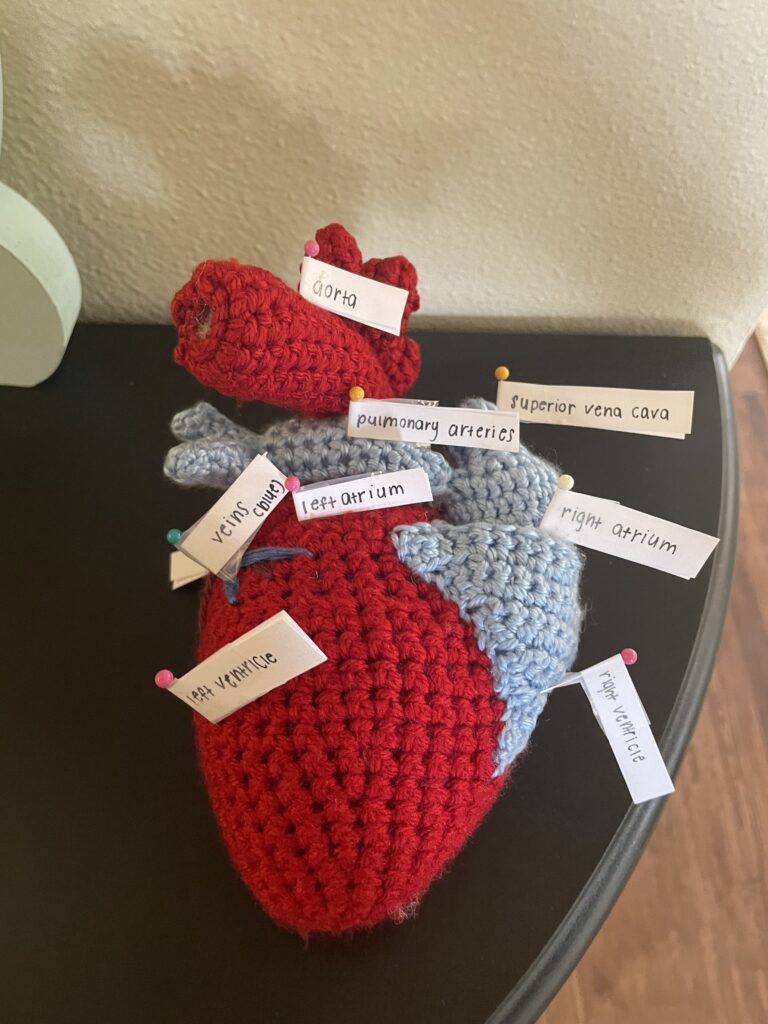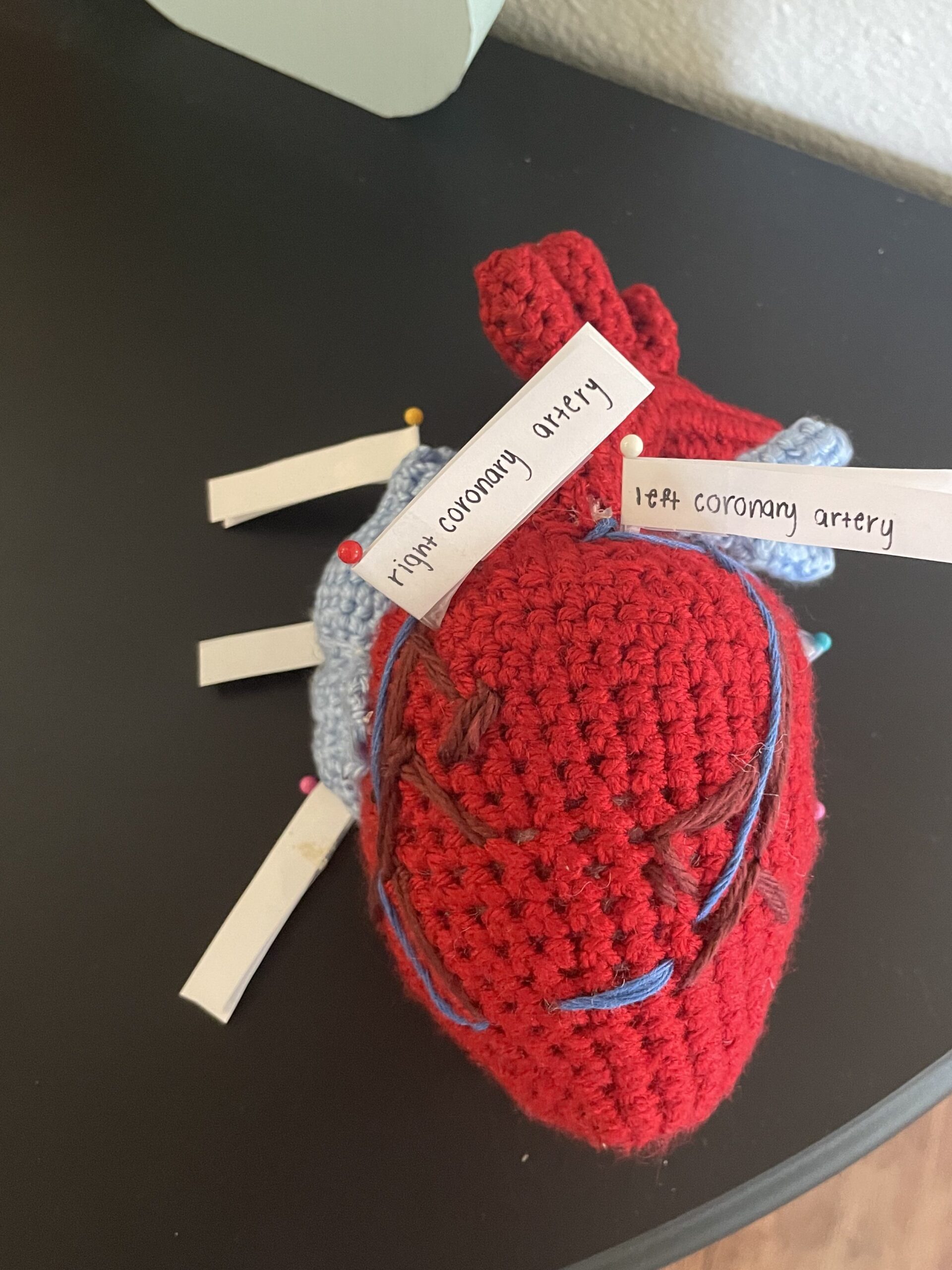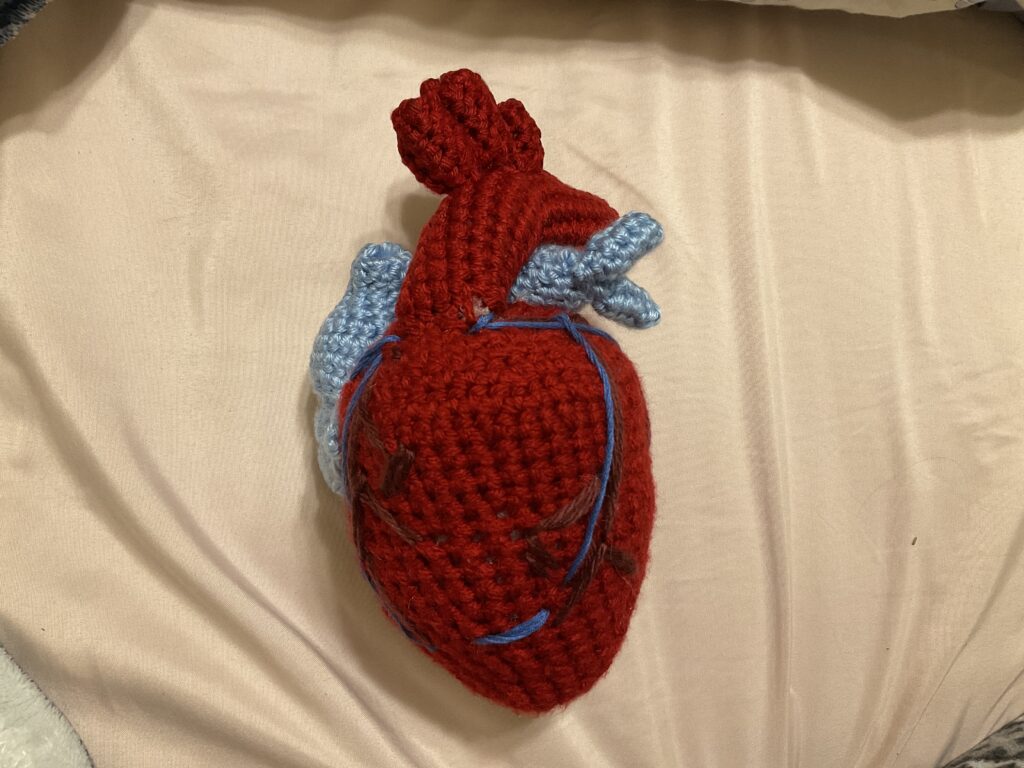



Coronary artery disease is the most common heart disease in the United States and is one of the leading causes of death in both developed and undeveloped countries. It’s important to understand how such a deadly disease affects the function and structure of the heart. The objective that I will cover is, to “Explain the structure and function of the heart”. With my visual, I crocheted the anatomy of the heart and labeled each structure of the heart including the following: the pulmonary artery, right atrium, left atrium, left ventricle, right ventricle, superior vena cava, aorta, veins, and coronary arteries. I indicated exactly where coronary artery disease affects the structure of the heart by pointing out the coronary arteries in dark red (what CAD affects) and the veins in blue.
To understand how coronary artery disease affects the structure and function of the heart it’s essential to first understand the structure of the heart and the importance of these structures to its functions. The heart is four-chambered, with four one-way valves, and a set of arteries and veins that regulate the normal flow of blood within the body. The right atrium receives deoxygenated blood from the body and this blood flows directly into the right ventricle. From the right ventricle, blood is pumped into the pulmonary trunk and then, the blood is taken to the lungs where the blood is oxygenated (Buckberg, 2018). The oxygenated blood is then delivered to the left atrium through four pulmonary veins. Once the blood is pumped into the left atrium, blood is moved into the left ventricle whose job is to pump blood into the aorta which is the largest artery of the body that delivers oxygenated blood to the circulatory system and completes the main function of the heart which is to pump blood and oxygen around the body (Cleveland Clinic, 2023). Within the walls of all four chambers of the heart, the muscle layer of the heart or the myocardium is found. The function of the myocardium is to give enough force to circulate blood through the heart and the rest of the body. Coronary artery disease is a type of heart disease in which there is an inadequate supply of blood and oxygen to the muscular tissue of the heart (myocardium). Its main cause is the blockage of coronary arteries. The blockage of coronary arteries is due to a build-up of atherosclerotic plaque. Plaque is a build-up of fatty material that is what impedes blood flow, which is important to the function of the heart. Over time this build-up of plaque, usually due to high blood pressure, cholesterol, smoking, diabetes, and other health conditions can become large and if it becomes large enough it will cause a block in the coronary arteries. This block causes major harm to the function and structure of the heart (Shahjehan & Bhutta, 2023). The coronary arteries run along the coronary sulcus of the myocardium of the heart. Their main function is to supply blood to the heart, and they also provide oxygen to the muscular tissue of the heart which allows for the heart to contract keeping the circulation of blood going throughout the body. This is a crucial function for myocardial function and subsequently homeostasis of the body. This blockage of an artery will lead to angina (chest pain) and if the blood starts to clot it will lead to a heart attack or cardiac arrest if the muscle tissue begins to die from a lack of oxygen. Coronary artery disease will not allow blood to flow to crucial areas which is the entire function of the heart. These fatal effects are reasons why it’s important to understand not only the foundational structure and function of the heart but also how heart diseases such as coronary artery disease affect the structure and function of the heart (Malakar, 2019).
References:
Buckberg, G. D., Nanda, N. C., Nguyen, C., & Kocica, M. J. (2018, June 4). What is the heart? anatomy, function, pathophysiology, and misconceptions. MDPI. https://www.mdpi.com/2308-3425/5/2/33
Malakar, A. K., Choudhury, D., Halder, B., Paul, P., Uddin, A., & Chakraborty, S. (2019). A review on coronary artery disease, its risk factors, and therapeutics. Journal of cellular physiology, 234(10), 16812-16823.
professional, C. C. medical. (n.d.). How blood flows through your heart & body. Cleveland Clinic. https://my.clevelandclinic.org/health/articles/17060-how-does-the-blood-flow-through-your-heart
Shahjehan RD, Bhutta BS. Coronary Artery Disease. [Updated 2023 Aug 17]. In: StatPearls [Internet]. Treasure Island (FL): StatPearls Publishing; 2024 Jan-. Available from: https://www.ncbi.nlm.nih.gov/books/NBK564304/#

Sarah’s project is on the affects of coronary artery disease on the structure and function of the heart. Sarah displays a four chambered heart through her crochet skills. It is important to understand the structure of the heart, when further understanding how the disease affects the structure. Sarah’s use of crochet and labeling was not only an intricate and impressive visual, but also a very thorough one. Coronary artery disease is a type of heart disease in which there is an inadequate supply of blood and oxygen to the muscular tissue of the heart. Its main cause is the blockage of coronary arteries. The blockage is caused by a build-up of atherosclerotic plaque. Plaque, referring to a build-up of fatty material that is what blocks blood from flowing. Sarah’s visual shows the four chambers of the heart with four one-way valves, and a set of arteries and veins that regulate the normal flow of blood within the body. The heart provides crucial circulation, therefore anything that puts the flow of things in jeopardy causes crucial damage. The main function of the coronary artery is to supply blood to the heart, and they also provide oxygen to the muscular tissue of the heart, allowing the heart to contract keeping the circulation of blood going throughout the body. This is crucial in maintaining homeostasis because the blockage of an artery would lead to angina. If blood starts to clot it will lead to a heart attack or cardiac arrest. Sarah stresses that the disease’s fatal effects are reasons why it’s important to understand the structure and function of the heart but also how coronary artery disease affects the structure and function of the heart. I thoroughly enjoyed Sarah’s visual and overall content.